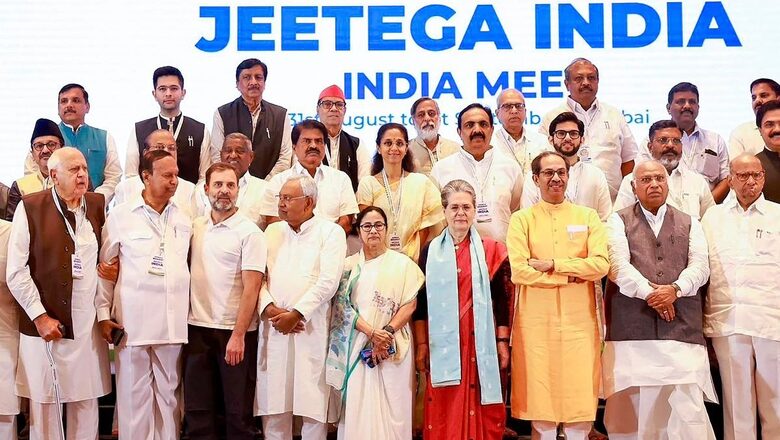
views
Lights, camera, run – this is how the INDIA bloc’s story has unfolded in the last four months. Since the first alliance meeting at Delhi in September last year, the opposition alliance is left with the DMK in Tamil Nadu, Shiv Sena (Uddhav Thackeray faction) in Maharashtra, CPM in Kerala, RJD in Bihar and SP in Uttar Pradesh.
As the leader of the Congress, the major partner of INDIA, Rahul Gandhi proceeds with his Bharat Jodo Nyay Yatra while his allies are on an “INDIA chhodo” spree, said a senior JD(U) leader, whose party switched sides and joined its former political adversary BJP on Sunday.
Out of the remaining allies, RJD leaders have agreed to stick to the INDIA bloc as they feel that distancing themselves from the coalition might affect their Muslim vote bank in Bihar. The DMK has an almost negligible role or presence in national politics as the party’s strength is limited to Tamil Nadu. The Samajwadi Party seems to be a depleting force in Uttar Pradesh but have announced their decision to give 11 seats out of a total of 80 in the state, to the Congress for the upcoming Lok Sabha elections.
In such a situation, what is the strength of the disintegrating alliance? Is the alliance fighting against Narendra Modi by banking on Muslim votes? Will Rahul Gandhi’s repeated assurance about the implementation of caste census across states help? How is the caste equation developing following the Bihar debacle?
These are some of the political-electoral questions experts are trying to decode while the scenario changes rapidly as India approaches the all-important general elections.
Did the NDA outsmart them all?
The opposition front now stands without the TMC and AAP, which refused to share seats in West Bengal and Punjab, and now the JD(U) in Bihar. Sandeep Shastri, a senior political analyst and national coordinator at Lokniti Network, said the current situation looks “challenging” for the opposition, especially for the Congress.
“The nucleus of the INDIA bloc looks shaky. The JD(U) clearly needed to save face for jumping ship, and that is why they blamed the Congress. Mamata Banerjee, too, trained guns at the Congress, which also did not think this through or see this coming. The leaders started their election campaign and embarked on a tour, but failed to win the trust of regional allies. A day before they entered Bengal, Mamata quit the alliance in her state; a day before the party was scheduled to reach Bihar, another ally pulled out of the INDIA bloc and joined the rival group. With such developments, it seems that the NDA has outsmarted them all and are setting the agenda, while the opposition is merely reacting,” Shastri said.
“It appears that all political parties are fighting for their individual space and their personal ambition. There is no unity over the agenda. Even political parties could not come together on the issue of the consecration ceremony. The relevant adage for them will be: divided we stand, united we fall,” he added.
Opposition’s dwindling vote bank
Out of a total of 543 seats, there are 131 reserved seats. The number includes 84 for SCs while 47 for STs. With the assembly election results in Madhya Pradesh and Chhattisgarh, the BJP appears to have made significant inroads in the Dalit and tribal vote bank.
The Muslim community’s pattern of voting for anti-BJP parties, the Congress or regional forces as a bloc, also seems to have changed. An analysis into the results of the 2019 elections and the last significant poll in Gujarat, Uttar Pradesh and Karnataka show how Muslims have voted for the BJP.
Additionally, Prime Minister Narendra Modi’s overt outreach to some Muslim groups and sub-groups, some Christian groups changed the electoral chemistry of these communities as well, said experts.
After the Bihar and Bengal debacle, the Congress and its allies in the opposition bloc are left with fewer options when it comes to counting a vote bank that is solely theirs. West Bengal chief minister Mamata Banerjee, who has severed all ties with the Congress in the state, said she will remain a part of the alliance but will not share seats. No politician or political party has, however, made any comment on her decision as to how this formula will work.
A senior Trinamool leader said the party is now looking at a “post-poll alliance” and will fight against the BJP with all its strength in Bengal. This makes the electoral equation and fight in the state a bipolar one.
It is now going to be a straight fight between the TMC and BJP, while the Congress and CPM alliance is likely to be a fringe player. The results of past elections, including Lok Sabha, assembly, panchayat and municipal, show how the Congress support base has only depleted even in their strongholds like Murshidabad and Malda, while the CPM has been wiped out.
In Bihar, with the JD(U) joining the BJP, experts said the OBC and EBC (economically backward class) as well as the upper castes are likely to vote for the NDA. “The BJP has managed to strategise the rainbow coalition of voters, which includes non-Yadav, Kurmi and other OBC votes along with EBC and upper caste. In fact, they have managed to get the Madhya Pradesh chief minister Manoj Yadav to work in Bihar among the Yadav voters,” said Shastri.
“The surveys that Lokniti did post 2014 and 2019 elections also showed that Muslims too voted for the BJP in some states. In fact, in Karnataka, the voting percentage of Muslims was in double digits,” he added.
Naveen Upadhyaya, a senior political analyst based out of Patna, said, “Bihar has always seen a caste-equation based election. The state did not vote for governance or development. So, whatever Nitish Kumar does and no matter how many times he jumps ship, the caste equations remain the same. His party will have a hold on its OBC and EBC voters, while the LJP and HAM will have a hold on theirs. In addition, the BJP too has a good support base across the Hindi heartland including Bihar. The consecration of Ram Temple may add some momentum to that, while the RJD is solely dependent on Muslim and Yadav votes. One has to consider that the voting pattern of Lok Sabha and assembly elections are different. In 2019, the BJP won all the 17 seats it contested.”














Comments
0 comment